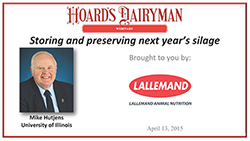
To best prepare for 2015, we should examine 2014's corn silage and look at ways to make it better.
Mike Hutjens, University of Illinois, presented the monthly Hoard's Dairyman webinar, "Storing and preserving next year's silage."
A visible culprit of damaged feed is yeast, mold and mycotoxins. As the feed analysis reports show, some producers are avoiding these villains' impact. However, nearly one-third of farms had exceedingly high yeast levels. But, the most costly problem is mycotoxins. When milk has high aflatoxin levels, it isn't saleable and producers in Illinois and Indiana lost milk income due to the high levels in their bulk tanks last year.
Hutjens encouraged the use of inoculants on all silages, but especially on grass silages, as they are generally wetter. Inoculant use shows a 3 percent improvement in dry matter recovery and a 3:1 savings on nutrients preserved. But, when you look at cost to benefit ratios, a 6:1 ratio is a valid reason to use inoculants.
When it's time to harvest the silage, consider your processing options. When Midwest corn silage was lab tested, only 10 percent were correctly kernel processed. "Producers are losing out on production when silage is not well processed," remarked Hutjens.
As silage is being harvested, Hutjens stresses filling silos or bunkers quickly and packing well. Over 15 pounds of dry matter per cubic foot can minimize oxygen in the pile. Heavier tractors can help, but be aware of muddy tires on packing tractors, as they can impact fermentation and add to shrink loss.
Once silage is packed, it needs to be sealed to begin the fermentation process. Wrapping sidewalls and overlapping the top layer by 6 to 8 feet is suggested. There are several oxygen-barrier products on the market that can further reduce dry matter losses, but these do carry a higher cost.
When you start feeding, remove 6 to 8 inches per day from the face of a pile. Be sure to just remove the daily portion needed and not expose more silage to oxygen than necessary. For those who use bags, remove 12 inches daily, patch any holes and keep the general area clean as to not encourage rodent traffic.
Whether you grow your own corn silage or purchase it, it's important to build a corn silage budget. This helps you take into account corn grain prices, harvest costs, inoculants and feed shrink.
The webinar was sponsored by Lallemand Animal Nutrition.
Learn more about planning for the 2015 silage crop, watch the April webinar. It's archived and available for viewing. Past webinars can be found at www.hoards.com/webinars.
Webinars or Crops and Forages follow these links.

The author is the online media manager and is responsible for the website, webinars and social media. A graduate of Modesto Junior College and Fresno State, she was raised on a California dairy and frequently blogs on youth programs and consumer issues.









